After conducting the Magic Tea demonstrations it became clear that the intervention had potential for promoting the right mind-states towards a self-transcendent experience (STE). A Wizard of Oz technique was used to simulate automated interactions. Over the past months the system has been prepared to allow users to operate the installation autonomously. This blogpost describes the system, its use, its support of the Factors for Awakening. And finally, the results of the measurement of perceived mystical experience.
The installation
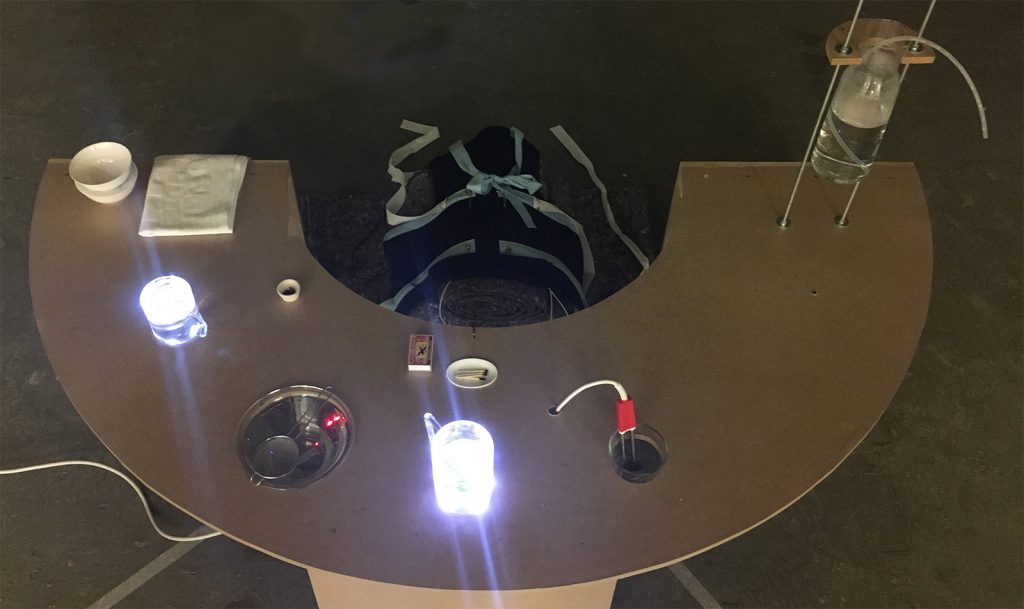
The main purpose of this prototype was to answer the question: Can an interactive system using bio-data and wholeness-inducing design invite an STE during the act of preparing and drinking tea? The Magic Tea installation (fig. 1) consists of three main parts: an apron, a table and a cup. All the parts are Wi-Fi enabled. They are connected to an Internet of Things platform where rules determine how the devices interact depending on the users’ and systems state. With the installation, users can make a cup of tea and every part of the process has been modified and technically enhanced.
The apron
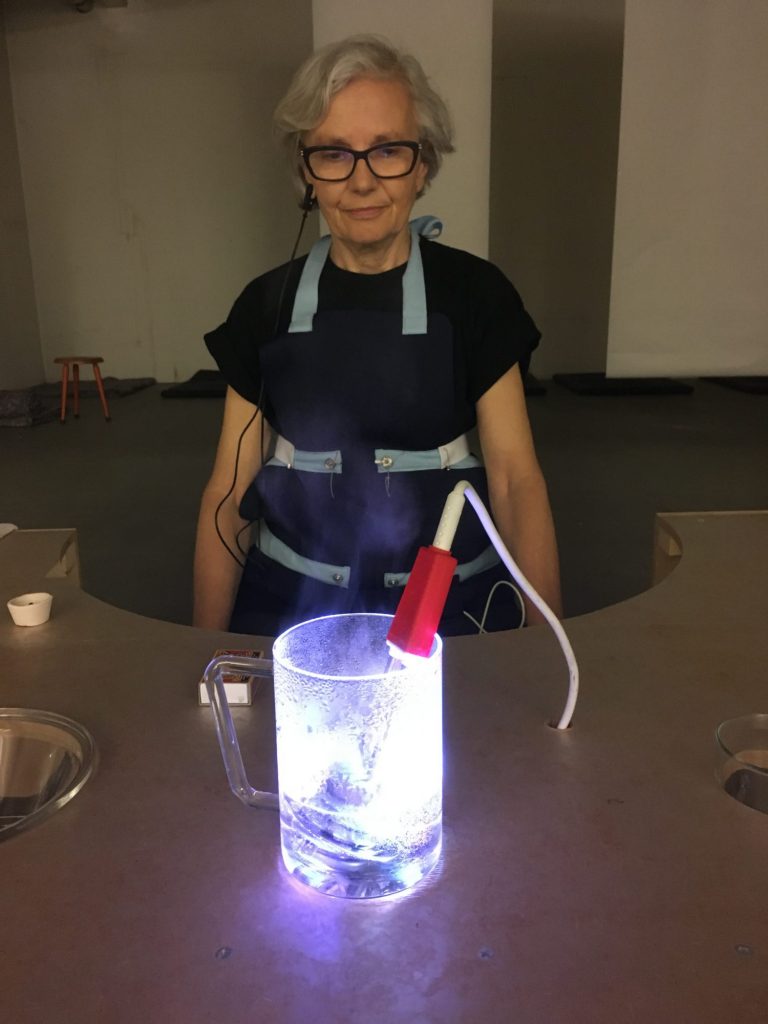
This wearable device (fig. 2) is used to measure pulse via a clip attached to the earlobe and breath flow at the chest using a resistive stretch sensor. It is worn throughout the experience.
The table
The table design (fig. 1) applies some of Alexanders 15 properties to promote a sense of wholeness. It is designed to support and augment the steps of the process. The steps have been laid out on a custom table in a half circle to create a sense of unfolding. The tables houses sensors which detect the actions and system state. Two sets of bright, full-colour LEDs pulsate during the boiling and seeping phase following the breath flow of the user. An immersion heater for boiling the water is also attached to the table. An interactive audio server provides environmental sounds. A speaker is placed under the table.
The cup
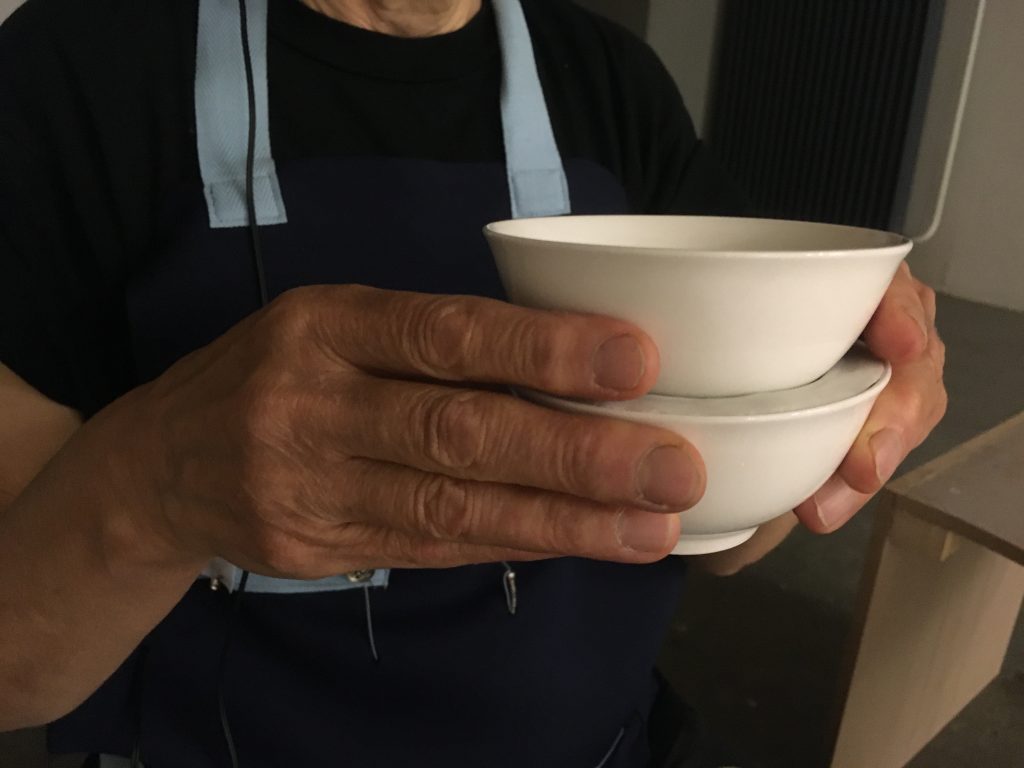
There was no clear preference for a type of cup from the tea scenarios experiment. But a small, white bowl was deemed suitable for a special taste experience. Stacking two of these bowls (fig. 3) was a practical way to create space for the electronics and to prototype the interaction and actuators. The main focus was on the interaction and experience design not the aesthetics. The cup houses three actuators: two blinking white LEDs and a pulsating mini vibrating motor. Both represent the users heart-beat. An MP3 player plays a wind sound to the rhythm of the users’ breath flow.
Making tea
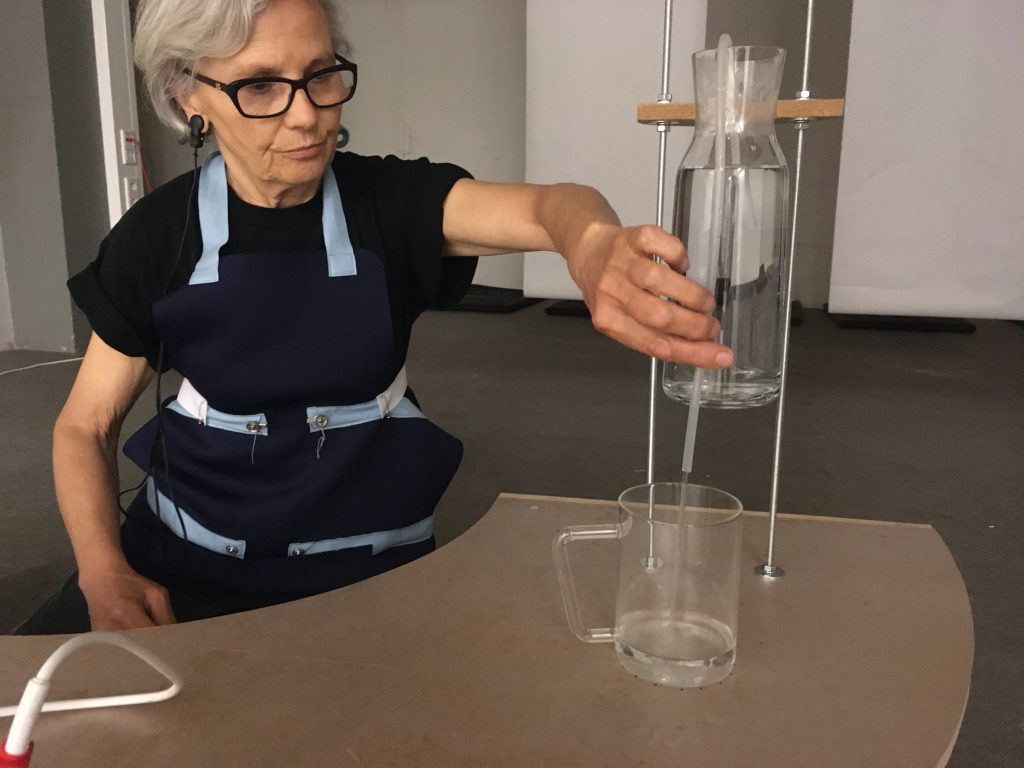
The four main steps of making tea: tapping and boiling water, seeping and drinking the tea can all be preformed with the installation. The who process takes about 15 minutes. The steps have been modified in various ways to support appropriate mind-states included in the Factors for Awakening. Transparency for example, has been used in the first thee steps to create interest and a sense of wonder and awe. The processes of tapping and boiling water have been slowed down using unfamiliar techniques and equipment like siphoning (fig. 4) and an immersion heater. De-acceleration should promote relaxation, attention, concentration and calm.
The transformative process
During the whole activity live bio-data from the users was reflected in different objects using the media of light, sound and vibration. The main aim of this output is to augment bodily self-consciousness through extending the body in the objects. This may create a disequilibrium in the user and cause a shift in world view (Gaggioli, 2016). While drinking the tea the user may become aware of a match between their physiological processes and the stimuli presented in the cup. The boundaries between the user and the object are blurred. This experience presents the user with a new narrative about reality: the cup I am drinking from isn’t a static object completely separate from me. It is alive, constantly changing and interconnected with my living processes. Whilst I am drinking the tea, I am drinking myself.
The installation also uses entrainment: whenever two or more oscillators in the same field are pulsing at nearly the same rate, they tend to lock in and begin pulsing at the same rate (Heather, 2007). A soundtrack of wind blowing through pine trees is manipulated in such a way that it reflects a slow breathing rhythm. By using this technique users may subconsciously adjust their breathing. Slow breathing decreases heart-rate and promotes relaxation (Zaccaro et al., 2018). The installation stacks different interaction and design elements and maps them to the transformative process. This may promote associated mind-states and invite an STE.
According to the classic Buddhist text Himavanta Sutta, there are seven factors at play to arrive at awakening which is characterised by a state of equanimity (Access to insight, 1997). This is the traditional path when practising formal meditation. After intense and lengthy practice one may acquire equanimity. This project is interested in awakening and its accompany transcendent experiences outside formal meditation. Throughout this project the Factors for Awakening and the mind-states stress and relaxation have been tracked to determine the presence of these factors during interventions. These factors can been seen as factors which may promote transcendence.
The experiment
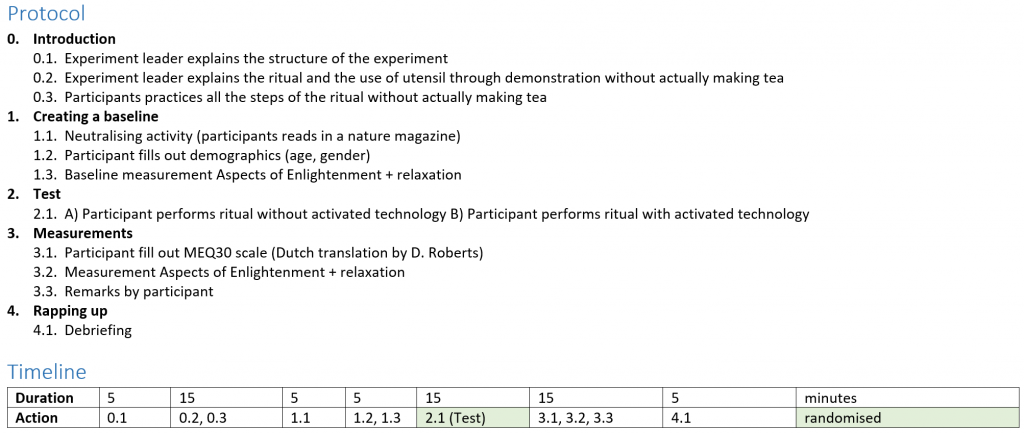
The goals of this experiment was to provide proof of concept: Magic Tea has a positive effect on the Factors for Awakening and invites a self-transcendent experience. The hypothesis was that the Magic Tea installation without technology will have a less transcendent effect than the technologically enhanced version. The two conditions used both validated (Revised Mystical Experience Questionnaire (MEQ; 30 items)), and non-validated 5 point likert scale (Factors for Awakening, stress & relaxation). Observation and an interviews gave more insight into the way users experienced the system and the feelings and associations it triggered. View fig. 5 for the full protocol.
Method
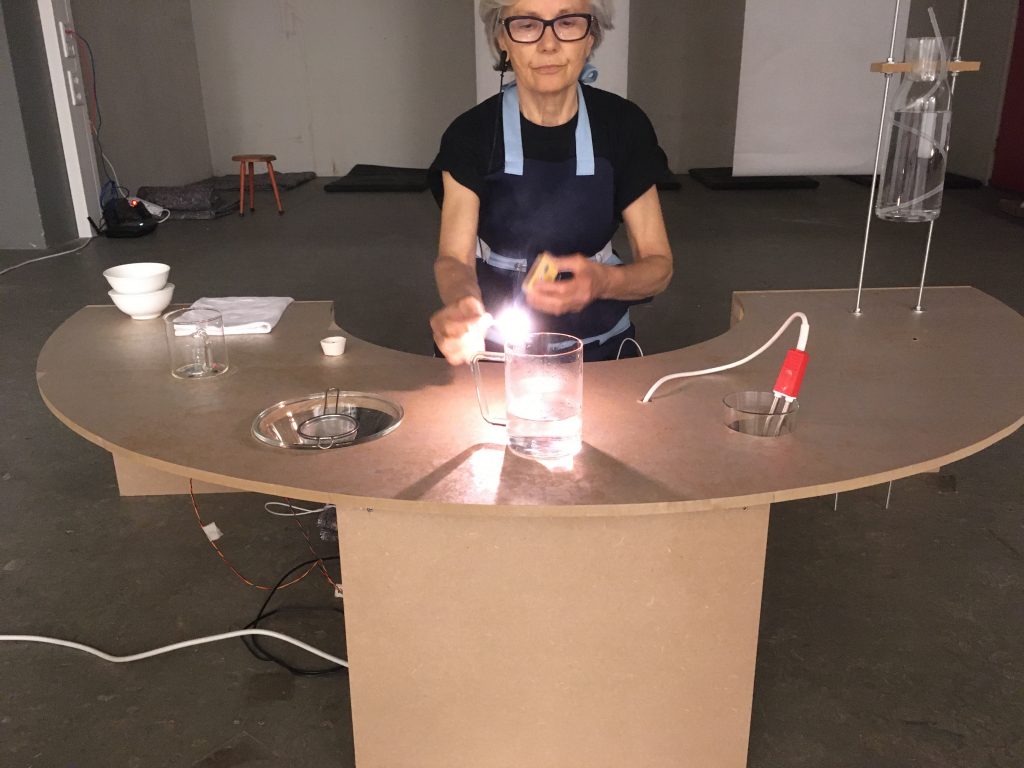
Two groups of five volunteers were invited to join a session one of two test days. By picking one of the days the participants assigned themselves randomly to one of the conditions. The first day the volunteers used the installation with all the sensors, actuators and media activated (fig. 6). The second-day participants performed the process and used only the analogue interventions of the prototype (e.g. tapping water and the immersion heater).
Perceived mystical experience was measured using the revised Mystical Experience Questionnaire. The MEQ30 is a validated scale to measure the mystical experience effects of hallucinogenic drugs (Psilocybin). These are comparable to non-drug induced experiences (MacLean & Griffiths, 2013. p. 12). MEQ is composed of four factors: Mystical (Internal Unity, External Unity, Noetic Quality, Sacredness), Positive Mood, Transcendence of Time and Space and Ineffability. Earlier research considered a mystical experience complete when a score of 60% of the total possible score on each dimension of the Mystical Experience Questionnaire was reached (Barrett & Griffiths, 2018).
Results
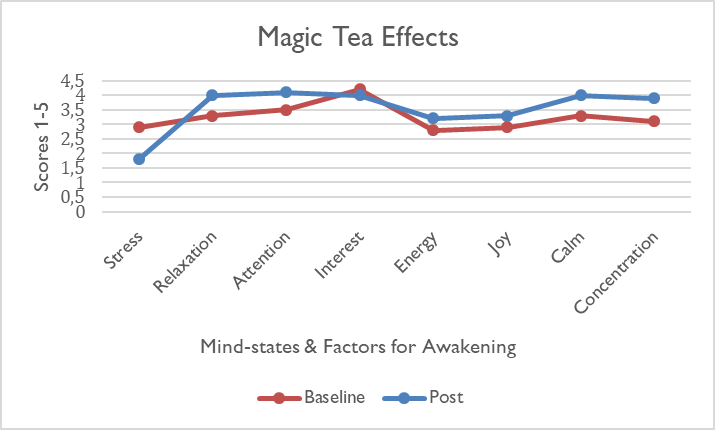
Fig. 7 shows the results for the Factors for Awakening measurement of both conditions combined, the results are positive compared to baseline. All factors increase except for interest which was the highest baseline score at 4,2. Stress decreases with 1,1 point and relaxation increases by 0,7.
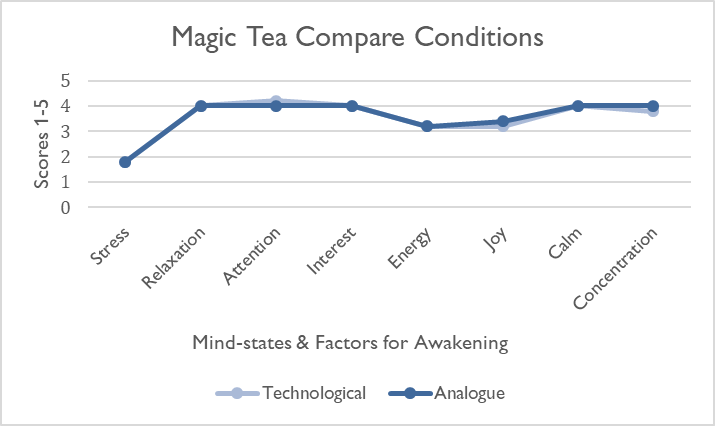
The two conditions differ very little (fig. 8). In the tech version attention scores 0,2 points higher, joy and concentration 0,2 lower than the analogue version. Both the analogue and the technologically enhanced version have a positive effect on the Factors for Awakening, stress and relaxation.
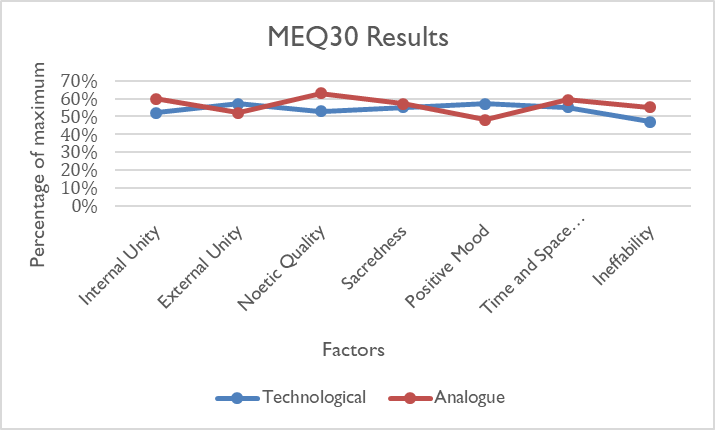
Results from the MEQ (fig. 9) show that the differences between Magic Tea use with and without technology are small. Out of a maximum score of 150, the tech version scores 81 (51%), the analogue 84 (56%). The tech version scores higher on Positive Mood (57%) and External Unity (57%). The latter correlates best with connectedness which was the purpose of boundary blurring between object and self. The hypothesis: A Magic Tea ritual without technology will have a less transcendent effect then the technologically enhanced ritual is false. The analogue version scores slightly better on the MEQ, just under the complete mystical experience of 60%. In the tech version non of the factors reach 60%. But scores just below 60% are promising for a prototype.
The main insights from the interviews and observations for both conditions:
- Participants find the experience very pleasant and relaxing.
- They experience a learning curve and wonder if they are doing it right. This takes them out of the experience.
- Most participants need time to get into it, once they arrive at the seeping and drinking they feel more present.
- The unfolding of the tea leaves is often mentioned as a highlight.
- They like drinking experience, the tea taste and the bowl.
- A heightened sense of awareness of body, thoughts and the contrast with the usual fast pace.
In the tech condition, users aren’t always aware of all the presented stimuli. Only some participants related the light and sound phenomena to bio-metric data, none of them recognised their own bodily processes. One explanation is that the breath data was only partially represented in the objects due to technical and design issues. However, participants did experience moments of awe and magic. As one participant explained: “I was truly affected by the transforming processes” and “for the first time in my life I experienced drinking something that felt like it’s alive.
Conclusions
In neither conditions a full mystical experience was reached. However scores on the Factors for Awakening questionnaire and the MEQ30 show the design promotes relevant mind-states and has potential for inviting an STE.
Strengthening the self-transcendent effect of the installation is the main point of improvement. This may be achieved by following two trajectories:
- Reduce the cognitive activity during use:
- flatten the learning curve (clarify the way to operate the installation)
- reduce distractions during the interaction (e.g. avoid technical hiccups, fine tune timing of media events)
- Optimise the inner state of the user before using the installation (creating a sense of inner and outer safety through optimising the space and regulating physiology by stimulating slow breathing for example).
References
Access to Insight. (1997). Himavanta Sutta: The Himalayas (On the Factors for Awakening). Retrieved from https://www.accesstoinsight.org/tipitaka/sn/sn46/sn46.001.than.html
Barrett, F. S., & Griffiths, R. R. (2018). Classic Hallucinogens and Mystical Experiences: Phenomenology and Neural Correlates. Curr Top Behav Neurosci., 36, 393–430. https://doi.org/10.1007/7854
Gaggioli, A. (2016).Transformative Experience Design. In Human Computer Confluence. Transforming Human Experience Through Symbiotic Technologies, eds A. Gaggioli, A. Ferscha, G. Riva, S. Dunne, and I. Viaud-Delmon (Berlin: De Gruyter Open), 96–121.
Heather, S. (2007). What Is Sound Healing? Wholistic Healing Publications, 7(3).
MacLean, K. A., & Griffiths, R. R. (2013). Factor Analysis of the Mystical Experience Questionnaire: A Study of Experiences Occasioned by the Hallucinogen Psilocybin. Journal for the Scientific Study of Religion, 51(4), 721–737. https://doi.org/10.1111/j.1468-5906.2012.01685.x.Factor
Zaccaro, A., Piarulli, A., Laurino, M., Garbella, E., Menicucci, D., Neri, B., & Gemignani, A. (2018). How Breath-Control Can Change Your Life: A Systematic Review on Psycho-Physiological Correlates of Slow Breathing. Frontiers in human neuroscience, 12, 353. https://doi.org/10.3389/fnhum.2018.00353
In collaboration with: Avans University of Applied Sciences, Centre of Applied Research for Art, Design and Technology (CARADT)